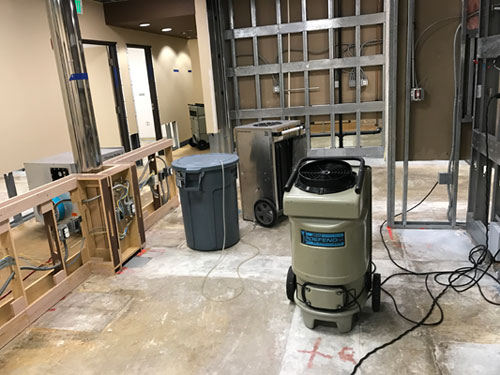
Flooding from rising waters is rare, but other causes can lead to major destruction as well. Even if that damage is hidden and slowly progressing. Crawl spaces, attics, and basements are especially prone to water damage. You’ll likely spot an appliance leak fairly soon, but problems such as those inside walls can remain completely hidden for weeks or even months. So keep an eye out for any signs of discoloration, dampness, mold, and odors. Old water stains suggest an intermittent problem. If you find damp areas, act immediately while the problem is easier to track down and hasn’t had time to cause extensive damage.
Many of the people who call us are quite certain of where the leak is coming from, only to find out later they were wrong. That’s because water can travel quite a distance, even upwards, before it makes itself known. So a professional inspection or leak detection is usually better than just fixing what may or may not be the main cause.
Building Leaks
Have you noticed water stains on the ceiling? Roof leaks are probably the cause, but not always. Besides a leaky pipe in the attic, there could be condensation plumbing (or just about any surface for that matter). With a clogged gutter or blocked downspout water can make its way into the attic then down to the ceiling. And roof leakage isn’t always due to bad or missing shingles. Damaged or poorly installed flashing around chimneys, vent pipes, and joints can also become a problem. The seals around skylights can get old, and the skylight itself can crack.
Other common building leaks occur at the seals on windows and doors, as well as at caulking where they join the wall. Siding and stucco can be damaged, and the joints between a deck and the house are also prone to leaks.
Plumbing and Appliances
A bit surprisingly, clothes washers are the #1 cause of home flooding and water damage. Sure, they sometimes overflow or their drain gets clogged. But old washer hoses can burst and release several hundred gallons of water before you even know it. Water heaters are another contender. Valves and fittings can leak, and in extreme conditions, the tank can rupture. That can release 40, 50, or more gallons in a matter of seconds.
Just about any appliance that uses water can leak. So don’t neglect dishwashers, garbage disposals, and ice makers. A plumbing leak that seems small may be more serious than you think. Leaky pipes can easily release a few hundred gallons per month, overwhelming evaporation. Sump pumps can fail, and bathtubs can overflow. And whether you have central A/C or a window air conditioner, condensation can flow to where it can slowly cause mold and other water damage.
Humidity and Condensation
As you may have gathered, what seems like a leak may, in fact, be condensation. That’s a common problem with toilets in bathrooms with showers. It’s important to make sure that all kitchen and bathroom exhaust fans are working properly and that their vents are free of obstructions. Otherwise, you may find yourself needing mold remediation and repairs.
Condensation on windows can drip down and cause water damage on the frame and window sills. If you notice this often, consider using a dehumidifier or installing a whole-house dehumidifier.
